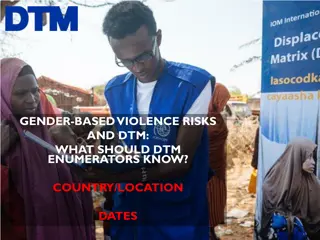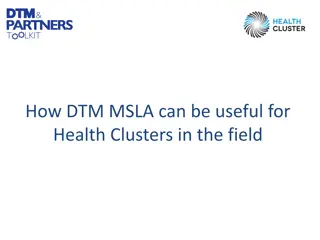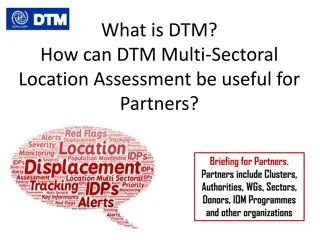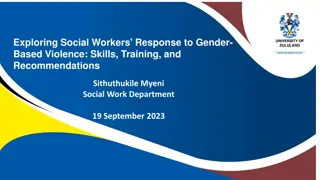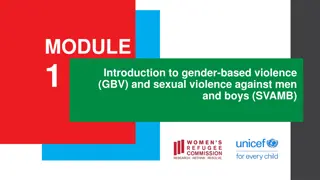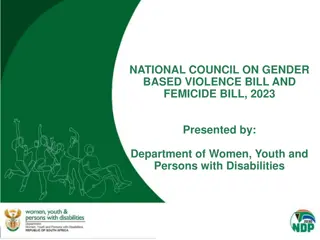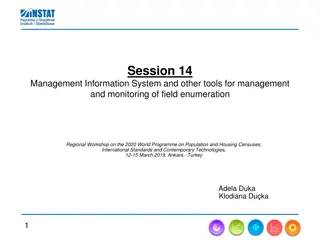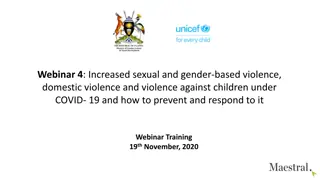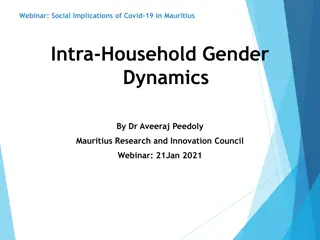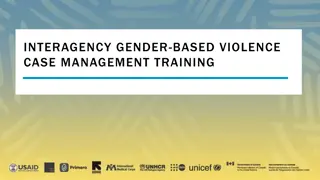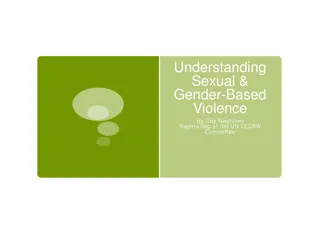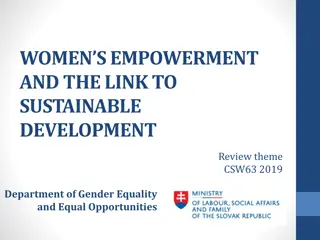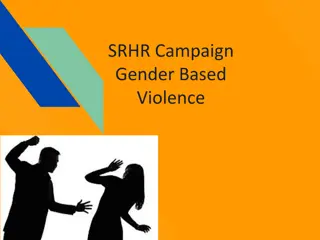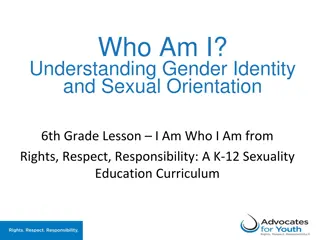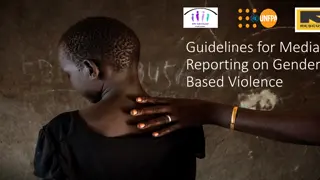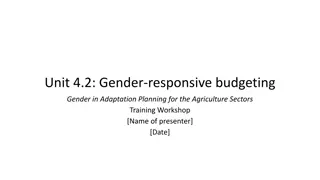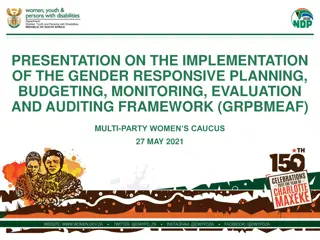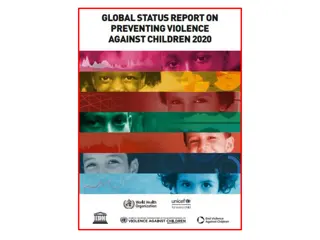Understanding Gender-Based Violence Risks and DTM Enumerators' Role
This content delves into the crucial aspects of gender-based violence (GBV) and the duties of DTM enumerators in recognizing, defining, and addressing GBV risks. It covers differentiating sex and gender, identifying forms and root causes of GBV, and understanding the impact of emergencies on exacerbating GBV risks. Additionally, it explores the true or false scenarios related to GBV, types of GBV, and the definition of GBV as an umbrella term for harmful acts based on gender differences. Through learning objectives and discussions on sex, gender, and cultural norms, this material aims to enhance awareness and preparedness in combating GBV.
Download Presentation

Please find below an Image/Link to download the presentation.
The content on the website is provided AS IS for your information and personal use only. It may not be sold, licensed, or shared on other websites without obtaining consent from the author. Download presentation by click this link. If you encounter any issues during the download, it is possible that the publisher has removed the file from their server.
E N D
Presentation Transcript
GENDER-BASED VIOLENCE RISKS AND DTM: WHAT SHOULD DTM ENUMERATORS KNOW? Turkey/Antalya Oct 17-18, 2018
Part 1 GENDER BASED VIOLENCE AND DTM
Learning objectives 1. Be able to differentiate between Sex and Gender 2. Define GBV 3. Identify forms of GBV, root causes, contributing factors and consequences of GBV 4. Understand how emergencies can exacerbate GBV risks GENDER BASED VIOLENCE AND DTM
Sex vs. Gender Sex Gender Social differences between males and females Physical/ biological differences between females and males Determined by social factors history, culture, tradition, societal norms, religion Does not change (without surgical intervention) Can change over time What are the gender traits of women and men in your culture, and how does this differ from other cultures? GENDER BASED VIOLENCE AND DTM
GBV true or false?- 1. GBV is about rape and sexual violence 2. GBV can be perpetrated against boys and men too 3. Culture needs to be always respected even if it is harmful for girls and women. 4. Domestic violence is the result of poverty and lack of education. 5. If a young woman wear an inappropriate dress that provoke men sexually, it s her fault to be raped. 6. Consequences of GBV are always same for all survivors. GENDER BASED VIOLENCE AND DTM
Gender-Based Violence (GBV) Gender-based Violence (GBV) is an umbrella term for any harmful act that is perpetrated against a person s will and that is based on socially ascribed (i.e. gender) differences between males and females. It includes acts that inflict physical, sexual or mental harm or suffering, threats of such acts, coercion, and other deprivations of liberty. These acts can occur in public or in private. GENDER BASED VIOLENCE AND DTM
Types of GBV Physical Assault Trafficking, Slavery Infanticide Honor Killing and Maiming Abuse, Humiliation Confinement/Isolation Intimidation/Threats Social Exclusion, ostracism based on sexual orientation PHYSICAL EMOTIONAL SEXUAL ECONOMIC Forced Marriage Sexual Exploitation/Forced Prostitution Survival Sex Rape and Marital Rape Child Sexual Abuse, Defilement, Incest Discrimination, and/or denial of opportunities Forced Marriage/Early Marriage Denial of Education for Women and Children
Understanding GBV- Exercise In groups of 5 people, identify: Root causes for gender based violence and risk factors that may increase the likelihood of GBV in your context? Consequences of different forms of GBV? - Physical, social, economic, psychological? GENDER BASED VIOLENCE AND DTM
Consequences of GBV Forms of GBV Root causes and contributing factors GENDER BASED VIOLENCE AND DTM
Root causes and contributing factors of GBV GENDER BASED VIOLENCE AND DTM
Consequences of GBV GENDER BASED VIOLENCE AND DTM
Why does GBV occur in emergencies? Pre-existing - exists independent of, or prior to emergency or conflict Emergency-related - specific to/resulting from the disaster or conflict Humanitarian-related - caused directly or indirectly by humanitarian environment GENDER BASED VIOLENCE AND DTM
How is GBV exacerbated in emergencies? New threats/forms of GBV related to conflict Lack of privacy; overcrowding; lack of safe access to basic needs Design of humanitarian aid heightens or introduces new GBV risks Separation from family members; lack of documentation; registration discrimination Breakdown of protective social mechanisms and norms regulating behaviour Increased vulnerability and dependence; exploitation Introduction of new power dynamics, as with humanitarian actors GENDER BASED VIOLENCE AND DTM
Summary of GBV Part 1 GBV is rooted in gender and power inequalities that exist outside of conflict or disaster but that can be exacerbated by it. Always assume that GBV is occurring. Obtaining data about incidents cannot be used as evidence , and is NOT advisable and NOT our role in an emergency. GENDER BASED VIOLENCE AND DTM
Part 2 GENDER BASED VIOLENCE AND DTM
Learning objectives Understand the role of non-GBV specialists in GBV prevention, mitigation and response Know how to safely and ethically respond to a GBV and child protection incident disclosure GENDER BASED VIOLENCE AND DTM
Roles and responsibilities towards GBV SPECIALIZED PROGRAMMING: specialists Direct service delivery GBV MAINSTREAMING all actors Avoid creating or exacerbating risks of GBV Reduce existing risks Understand and link to specialist services for GBV survivors Applying core minimum standards into agency activities Case management GBV specialized psychosocial support Clinical care Legal support Economic reintegration How to mainstream GBV in the DTM? GENDER BASED VIOLENCE AND DTM
What a DTM enumerator should do to mainstream GBV Avoid creating or exacerbating risks of GBV. Inform yourself about services available for GBV survivors GENDER BASED VIOLENCE AND DTM
Avoid creating or exacerbating risks of GBV IOM Standards of Conduct Prevention of Sexual Exploitation and Abuse (PSEA) by aid workers Do no harm GENDER BASED VIOLENCE AND DTM


